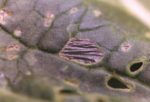Diamondback moth
Plutella xylostella ()
Lepidoptera: Plutellidae
The Diamondback moth, Plutella xylostella is known under the following synonyms: Plutella maculipennis (), Plutella brassicola , Cerastoma xylostella , Plodia maculipennis (), Plutella cruciferarum , and Plutella maculata .
Why is P. xylostella difficult to control?
- high reproductive rate
- resistant to many insecticides
Host plants and damage

Diamondback moth feeds only on plants belonging to the Cruciferae family (e.g. pak-choi, cabbage, radish).
Plant growth stages affected
Seedling stage, vegetative stage, flowering stage, and fruiting stage. Plant parts affected include leaves, fruits/pods, inflorescence, stems, and growing points.
Affected plant parts
The insect larva is a leaf surface feeder.
Symptoms
P. xylostella feeds voraciously with its chewing mouthparts on the undersides of leaves leaving a papery epidermis intact. This type of damage gives the appearance of translucent windows in the leaf blades. In cases of severe infestation entire leaves can be consumed.
Morphology & biology

Insect larvae and in some cases pupae are found on damaged leaves.
First instar larva is greenish yellow in color. The second instar is green; the head is brown with light patches. Mature larvae are 12-16 mm long and 1.5-2.0 mm wide.
The adult is greyish brown with a 9-mm long body and a wingspan of about 12-15 mm. When wings are folded, three or four diamond-shaped areas formed by forewings are visible on the dorsal side when the moth is at rest.
Monitoring

In young plants, carefully inspect the growing tips and determine if stunting has occurred. Look at the undersides of leaves for chewing injury. Commonly, larvae drop off the leaves and spin down on a silken thread when disturbed.
Pest management
Except for the first instar all P. xylostella larvae and pupae are exposed on the leaf surface and therefore are affected by various abiotic factors. Several reports indicate that mortality of P. xylostella is linked to rainfall; consequently, this pest is serious only during dry seasons.
Biological control
Introduction of exotic parasites to control pest insects has been practiced for decades. This approach has considerable promise for the control of P. xylostella. Widespread and often indiscriminate use of insecticides has frustrated recent control efforts and delayed the establishment of parasites and their beneficial effects.
In the highland areas of the Philippines Diadegma semiclausum is utilized as a natural antagonist. In the lowlands Cotesia plutellae is a parasitoid on diamondback moth, but cannot control the pest population without additional tactics.
Cultural control
Integrated Pest Management
Since parasites play an important role in checking P. xylostella population growth, introduction and conservation of parasites will be basic to any sustainable IPM programme. To implement IPM, farmers must coordinate their efforts because the practices of one farmer influence those of his or her neighbor. This applies to the development of insecticide resistance and to the introduction and conservation of natural enemies. Such coordination will be needed in small-scale agriculture where farms are often smaller than 0.1 ha and where many farms in an area are owned by different growers. By combining mustard as a trap crop with yellow sticky traps, the need for insecticides may be reduced.
Chemical Control
P. xylostella is resistant to practically all insecticides in many countries. Use of synergists, pyrethroids, and organophosphorus insecticides is proposed as one means to augment pesticide efficacy.
Recommendations for better management:
- do not mix insecticides
- determine the effectiveness of insecticides by monitoring pest numbers one day after application
- alternate use of insecticides with different active ingredients (e. g. pyrethroids and organophosphates)monitor